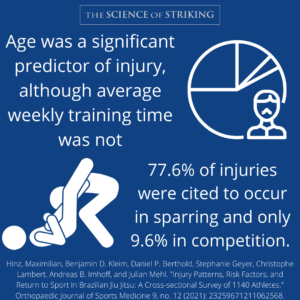Having an understanding of injury prevalence is of great importance to athletes and coaches, as well as medical and performance specialists working with those particular sports. This study contributed to the growing body of combat sports injury prevalence literature through a questionnaire based study of injury rates in Brazilian Jiu Jitsu (BJJ).
A 67-question online survey was completed by 1140 BJJ athletes, detailing injury history over the preceding 3 years. Injuries were defined as episodes that resulted in an absence from training for >2 weeks.
Over a 3 year period, 31.2% of athletes stayed injury-free, 48.7% suffered 1 injury, 16.6% 2 injuries and 3.5% 3 or more, for a total of 308 injuries per 1000 athletes/year.
27.1% of injuries occurred to the knee, 14.6% to the shoulder. The most common specific injuries were ACL tear, ankle ligament tear, MCL tear, meniscus injury and rib injury.
In terms of mechanism, 29.7% occurred during submission, 26.4% during takedown and 24% during guard pass. Of the submissions, the most common techniques causing injury were armbar (22.4%), kimura (12.6%) and heel hook (11%).
Contrary to previous research in BJJ and other sports, 77.6% of injuries were cited to occur in sparring and only 9.6% in competition.
Age was a significant predictor of injury, although average weekly training time was not. Brown belts had the highest incidence of injury, white belts the lowest.
Although a major limitation of this study is that it is based on retrospective data that was not confirmed by a medical professional, the large sample size provides a valuable contribution to the knowledge base in regards to injury epidemiology in this sport.
#bjj #grappling #brazilianjiujitsu #thescienceofstriking #combatsports #mma #ufc #bellator #onefc
https://journals.sagepub.com/doi/full/10.1177/23259671211062568
Hinz, Maximilian, Benjamin D. Kleim, Daniel P. Berthold, Stephanie Geyer, Christophe Lambert, Andreas B. Imhoff, and Julian Mehl. “Injury Patterns, Risk Factors, and Return to Sport in Brazilian Jiu Jitsu: A Cross-sectional Survey of 1140 Athletes.” Orthopaedic Journal of Sports Medicine 9, no. 12 (2021): 23259671211062568.



